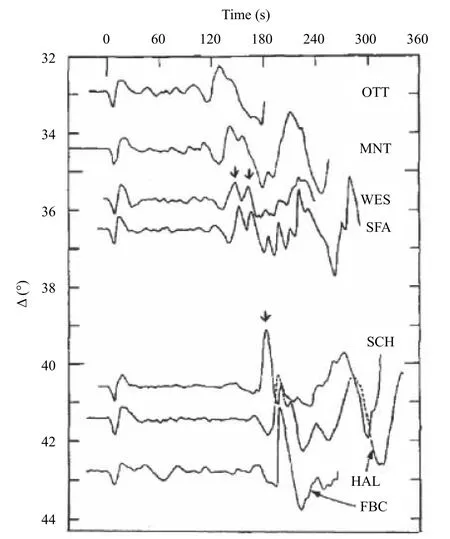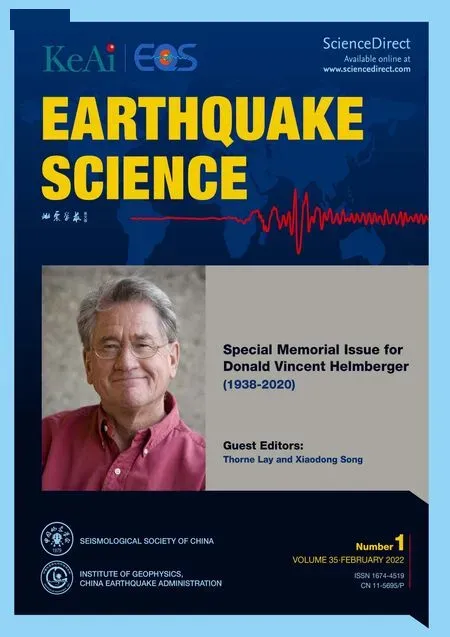Recollections of my mentor, Donald V. Helmberger
Stephen P. Grand
Department of Geological Sciences, Jackson School of Geosciences, University of Texas at Austin, TX 78712, USA
I arrived at Caltech as a graduate student in the summer of 1979. With a BSc degree in physics, I knew little to nothing about seismology or geophysics. The Seismo Lab encouraged new students to immediately start some research with a great latitude on what to work on.That summer I started projects relocating aftershocks of the 1978 Oaxaca earthquake with Karen McNally, learning a normal mode code with Bernard Minster, and investigating the source mechanism of the 1979 St. Elias earthquake with Hiroo Kanamori. I didn’t feel particularly excited by my early projects, probably due to my ignorance, so I was still open to some new direction.Senior students suggested I ask Don if he had any possible projects. After a brief discussion with Don, he called me to his office. On a large table in his office he had laid out paper copies of the north-south component seismograms from stations in eastern Canada. These showed tangential motions produced by the 1966 El Golfo earthquake that occurred in the Gulf of California. Don was excited and pointed out two peaks in the recordings at WES and SFA(marked in Figure 1) that seemed to coalesce to a single large peak at SCH. He thought they might be reflections from the discontinuities at 410 km and 660 km depth and suggested I model them. The arrivals were well after the S waves (they were SS waves) and given the computational resources available at the time it was not clear how to model them, so Don suggested looking into a new synthetic seismogram approach that he called “chapstick”(Chapman, 1978). Of course I had no idea what modeling entailed nor could I understand what was in the seismograms. But Don was encouraging and optimistic so I went off and learned the theory behind WKBJ synthetics and wrote a simple code to compute synthetic seismograms. At that point Don said “now for the fun part” and I began to make synthetics to compare to the data. Don was right, it was fun and I was hooked on modeling seismograms, like so many of his other students over the years.

Figure 1. Tangential component seismograms produced by the El Golfo earthquake recorded in eastern Canada (Grand and Helmberger, 1984a). S waves are aligned at zero time and the seismograms are normalized by the S wave amplitudes. Arrows above station WES indicate two peaks in the waveforms that appear to coalesce to one large peak at SCH.
Through trial and error, I was able to find a shear wave velocity model that fit the El Golfo seismograms, and to understand what paths waves took to produce the peaks in the seismograms. It turned out the first peak was a wave that turned near 200 km depth and the second from the discontinuity near 410 km depth. Don was happy with the results and wrote a short (10 pages) NSF proposal to fund me going forward. The model we developed was onedimensional, and unfortunately there was clear evidence that mantle shear velocities beneath the western United States and eastern Canada were different. That led us to search for data similar to the El Golfo earthquake data that sampled homogenous tectonic provinces. Modeling these data resulted in upper mantle shear velocity models for the East Pacific Rise-western United States, Canadian Shield,and the northwestern Atlantic Ocean (Grand and Helmberger, 1984a, 1984b). Realizing the potential of using the waveforms of multiple bounce P and S waves to investigate the upper mantle, Don encouraged a number of studies sampling the mantle on a global scale (Rial et al.,1984; Grand and Helmberger, 1985; Graves and Helmberger, 1988; Lefevre and Helmberger, 1989) and made efforts to model data in 2D structures (Helmberger et al., 1985a, 1985b) . Ultimately, using the ability to identify the mantle paths that produced individual pulses in complicated seismograms led to efforts to develop fully 3D mantle models using tomography methods that my classmate, Gene Humphreys, taught me (Grand, 1987).
Over the years I have been amazed at the many discoveries made by Don and his students. We would have a dinner at most AGU fall meetings and he would always be excited by the most recent results that one of his students had found that year. Don looked at structures spanning from the inner core (Song XD and Helmberger,1992) to the surface of the Earth (Helmberger and Vidale,1988) . In most of these studies Don used three skills that I think he was uniquely supreme in. First, he loved looking at seismic data and had the ability to notice significant features in seismograms that could be used to discover something about the Earth. I doubt if any other seismologist would have noticed anything unusual in the waveforms preceding the Love wave that led me to a career studying the mantle. His second skill was to understand what structural feature could cause an observed anomaly in a seismic waveform. He had an incredible intuition about seismic wave propagation. I was particularly impressed with his intuition when he started looking at 3D structures, for example multi-pathing of waves sampling the edges of the large low shear velocity provinces (Ni SD et al., 2005). His third strength was the ability to develop synthetic seismogram codes that were practical to use for solving Earth problems and to apply them. Starting in his graduate student days, he developed the Cagniard de Hoop method for computing synthetic seismograms (Helmberger, 1968) and used the approach to model observed seismograms. I believe he was the first to really try to match higher frequency waveforms with synthetics, ultimately leading to many discoveries. Over the years he modified synthetic methods applicable to more complex structures, but always based on a generalized ray approach. Even though he embraced numerical methods as they became more feasible to apply,his ray-based approach was productive due to the intuitive nature of the method and his ability to both interpret synthetics and data.
As an advisor, Don did not push his ideas hard but showed confidence and trust in his students to explore on their own. I remember early in my career asking him what to do next and he responded “whose project is this?”. I needed that comment to become more independent in my research and appreciated it a lot as I moved forward in my career. Don was very accepting of all the different personalities of his students and I think he was often amused by their different quirks. The only times I saw an indication of competitiveness in him was during the Saturday morning football games that he always participated in with students and other faculty. Aside from his great knowledge of seismic waveforms, I think Don’s greatest strength as an advisor was his infectious enthusiasm and joy when explaining seismic waveforms.
Donald V. Helmberger was a great, unique scientist and advisor of students. I owe him more than I can express and miss him dearly.
- Earthquake Science的其它文章
- A graduate student experience with Professor Donald V.Helmberger
- Exploring Earth’s boundaries with Donald V.Helmberger
- A strange symbiosis: Seismic ray theory and Saturday touch football — Donald V. Helmberger as a graduate advisor
- Donald V. Helmberger memoir — exceptional seismologist, teacher, mentor, friend
- A grand master of seismology and mentoring
- My seismology journey with Donald V. Helmberger

